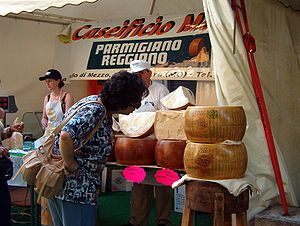Parmigiano-Reggiano
Parmigiano-Reggiano is a "grana", a hard, grainy cheese, cooked but not pressed, named after the producing areas of Parma and Reggio Emilia, in Emilia-Romagna, Italy. It is widely described by connoisseurs as the king of cheeses. Cheeses resembling Parmigiano-Reggiano but not made in this area are known as parmesan cheese.
It is made from raw cow's milk, collected immediately after milking and partly skimmed by gravity.
Traditionally, cows have to be fed only on grass or hay, producing grass fed beef. Only natural whey culture is (allegedly) allowed as a starter, together with calf rennet. The only additive allowed is salt. The product is aged an average of two years. The cheese is produced daily, and it can show a natural variability. True Parmigiano-Reggiano cheese has a complex fruity/nutty taste with a slightly gritty texture.
The name is trademarked, and in Italy there is a legal exclusive control exercised over its production and sales by the Parmigiano-Reggiano cheese Consorzio (created by a governmental decree). There are strict criteria each wheel must meet early in the aging process, when the cheese is still soft and creamy, to merit the official seal and be placed in storage for aging. Cheese which fails to meet these criteria is removed and fed to pigs, which are then used to produce prosciutto di Parma.
Uses of the cheese include being grated over pasta or eaten in chunks with balsamic vinegar. It is also a key ingredient in alfredo sauce and pesto.

History
According to the legend, the Parmigiano was created in the course of the Middle Ages in Bibbiano, in the province of Reggio Emilia. Its production spread soon to the Parma and Modena areas. Historical documents show that in the 13th-14th century Parmigiano was already very similar to that produced today: this suggest that its origins can be traced far before. It was praised as early as 1348 in the writings of Boccaccio, in the Decameron, he speaks of a mountain made completely of Parmesan to accompany macaroni and ravioli.
See also: List of cheeses, parmesan cheese
External links
| Asiago · Basket · Bel Paese · Bocconcini · Bra · Brös · Burrata · Caciocavallo · Caciotta · Caprino · Casciotta d'Urbino · Castelrosso · Casu marzu · Crescenza · Crucolo · Dolcelatte · Fontina · Gorgonzola · Grana (Padano) · Liptauer · Mascarpone · Monte Veronese · Morlacco · Mozzarella (di Bufala Campana) · Parmigiano-Reggiano · Pasta filata · Pecorino (Romano, Sardo, Siciliano) · Piave · Provolone · Ricotta · Robiola · Romano · Scamorza · Sottocenere al tartufo · Stracchino · Stracciatella di Bufala · Taleggio · Toma |

